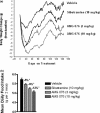Evaluation of AMG 076, a potent and selective MCHR1 antagonist, in rodent and primate obesity models
- PMID: 25505557
- PMCID: PMC4184568
- DOI: 10.1002/prp2.3
Evaluation of AMG 076, a potent and selective MCHR1 antagonist, in rodent and primate obesity models
Abstract
Melanin-concentrating hormone (MCH) regulates food intake through activation of the receptor, MCHR1. We have identified AMG 076 as an orally bioavailable potent and selective small molecule antagonist of MCHR1. In mouse models of obesity, AMG 076 caused a reduction in body weight gain in wild-type (MCHR1+/+) but not in knockout (MCHR1-/-) mice. The body weight reduction was associated with decreases in food intake and increases in energy expenditure. Importantly, we show that these MCHR1-dependent effects of AMG 076 were also reflected in improved metabolic phenotypes, increased glucose tolerance and insulin sensitivity. Preliminary data on effects of AMG 076 in obese cynomolgus monkeys are also presented.
Keywords: Antagonist; MCHR1; diabetes; obesity.
Figures







References
LinkOut - more resources
Full Text Sources
Other Literature Sources

